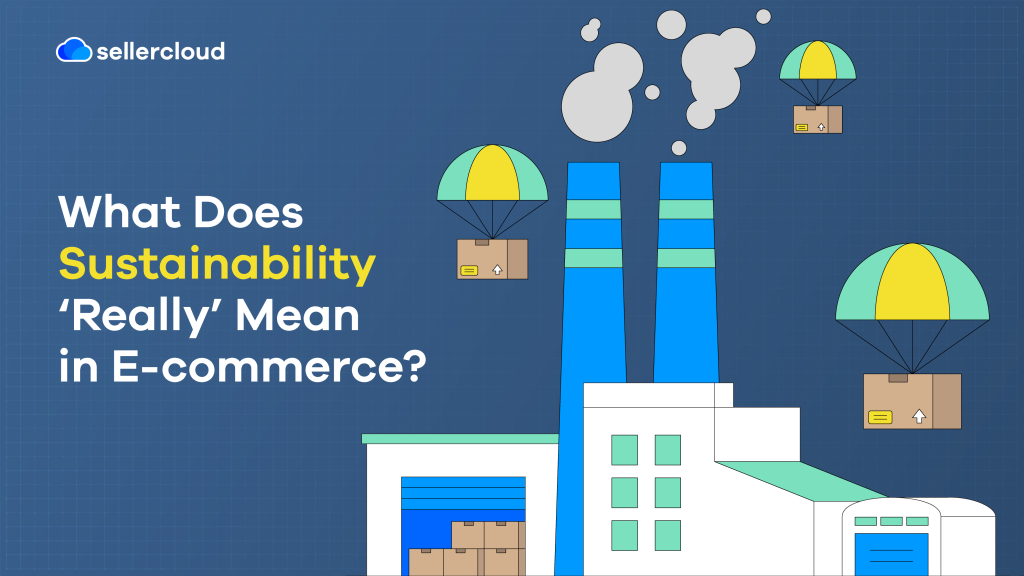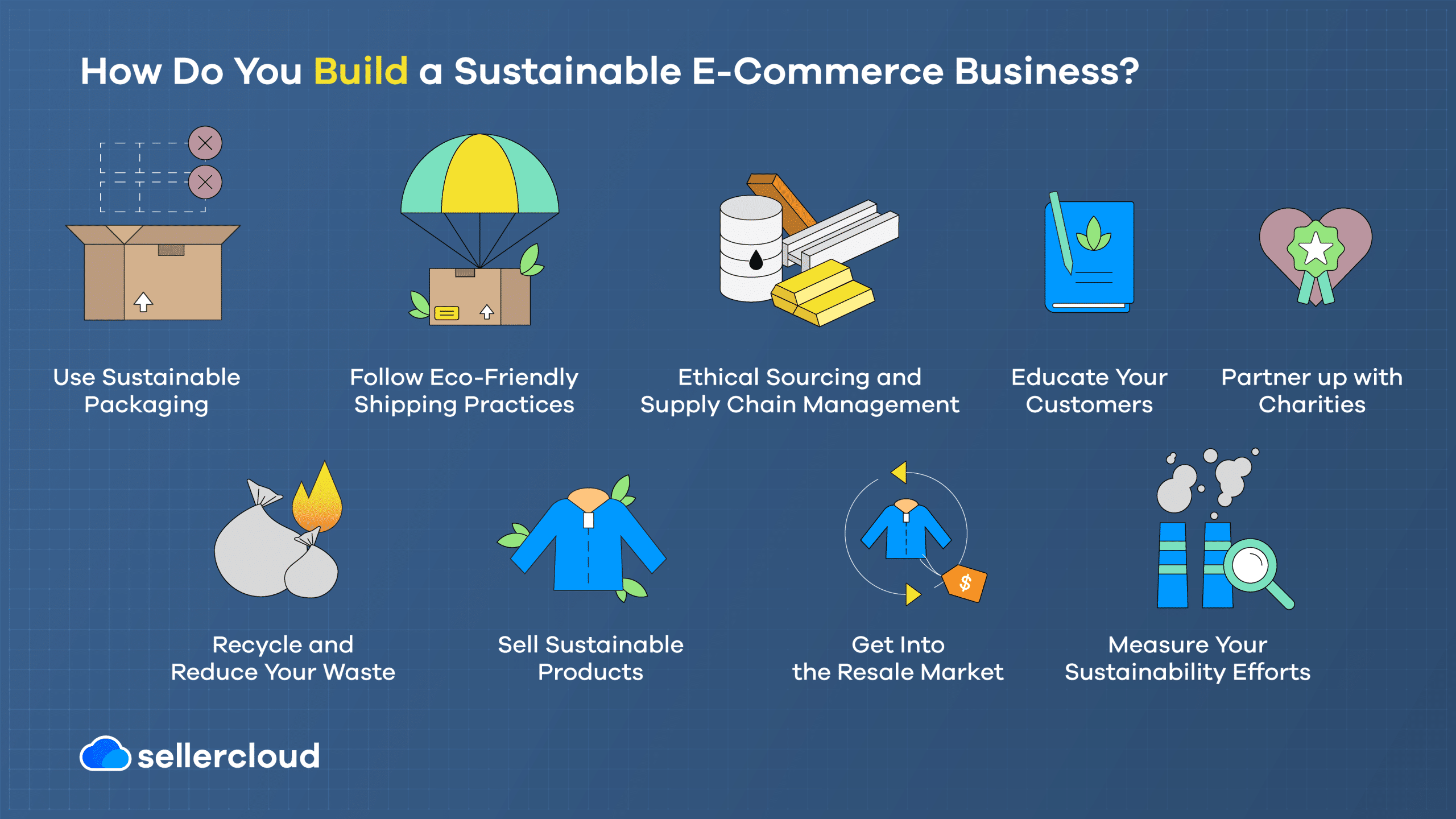
- Ecommerce can be less environmentally harmful than brick-and-mortar stores; however, ecommerce still produces enormous waste and emissions.
- Sustainable packaging, eco-friendly shipping, and customer education are just a handful of the things ecommerce companies can do to become more sustainable.
‘Sustainability’ is a term that gets thrown around a lot, but what does it really mean in the context of ecommerce? Many companies claim to be sustainable, but it can be hard to understand what they are doing and how to measure their impact.
That aside, sustainability is a major issue for many US consumers, and because it matters to them, ecommerce businesses must also take it seriously. According to an article by the National Oceanic and Atmospheric Administration, 2022 was the sixth hottest year, and 2023 is an El Niño year, which means climate scientists are predicting higher temperatures than ever.
Furthermore, sustainability is one of the most important warehouse trends of 2023, with many ecommerce companies looking to make their warehouses more environmentally friendly.
This article will explain why sustainability is vital to ecommerce customers, how ecommerce businesses can set and achieve sustainability goals, and common mistakes to avoid.
Why Is Sustainability Important for Ecommerce?

Whether you realize it or not, sustainability has always been important to ecommerce companies. It’s not just about being mindful of our environmental impact; your business will last longer if it is sustainable, and wasteful practices can cause your company to lose money.
Interestingly, ecommerce has traditionally been seen as greener than brick-and-mortar stores. An MIT study from 2013 found that “online shopping tends to have a better environmental impact than traditional shopping, when taking into account the entire buying process.”
It was noted that customer location and transportation choice also play a role. For example, in urban environments, it may be better for shoppers to shop traditionally rather than online. However, ecommerce being ‘generally’ better for the environment than traditional shopping might not be enough anymore.
A 2022 World Retail Congress report states that “retailers are responsible for more than 25% of global emissions.” That’s enormous.
In recent years, sustainability has only grown in importance. People know more about the environment than before and are more aware of their impact. This affects how people perceive your business, which they may avoid if they believe your company carries out harmful environmental practices.
According to NielsenIQ’s ‘Sustainability: the new consumer spending outlook’ report, in 2022, 78% of US consumers said that a sustainable lifestyle is important to them. It’s not just the young that care about sustainability, as many may think. According to some reports, older consumers are more concerned about the environment than younger generations.
McKinsey’s Consumer Pulse survey for 2022 suggests that younger demographics care more about “diversity, equity, and inclusion” while “older consumers pay more attention to health and environmental issues.” Lastly, as governments impose rules on emissions, ecommerce companies that don’t reduce their carbon footprint may face trouble.
What’s the Environmental Impact of Waste Generated by Ecommerce?
Waste generated by ecommerce businesses is a serious problem that affects the environment in multiple nuanced ways, with packaging waste and emissions being the most apparent. According to an article by Euronews, in 2021, Amazon generated more than 300 million kilograms of plastic packaging waste alone, not calculating the waste generated from other ecommerce platforms.
The WWF states that packaging waste accounts for one-third of household waste, and approximately 2-3% comes from ecommerce. What’s more worrisome for customers is that the impact of ecommerce on the environment is only growing. According to projections from the World Economic Forum made in 2019, by 2030, there will be 36% more delivery vehicles on the roads, and delivery vehicles will emit 25 million tons of CO2.
Many US customers are acutely aware of the environmental impact of ecommerce, which is influencing their buying decisions. Ecommerce platforms have been quick to capitalize on this trend and offer more environmentally friendly shipping services.
For example, Amazon introduced ‘Amazon Day Delivery,’ a free delivery option that enables customers to bunch several orders together to arrive in one shipment on a designated day. Amazon has also introduced ‘No-Rush shipping,’ a slower, non-priority shipping method that rewards customers for choosing it.
These shipping methods save Amazon fuel costs and also mean they can cut down on their emissions.
How Large Is the Sustainable Ecommerce Market Size?
Retail Drive reports that despite high inflation, the market share of sustainability-marketed products was 17.3% of purchases. Sustainable ecommerce now accounts for a sizable chunk of the market and is expected to grow substantially in the coming years.
According to statistics from SkyQuest, in 2021, global sustainable ecommerce was valued at $11.29 billion and will reach $40.75 billion by 2030, growing at a CAGR of 15.38% from 2023. However, it’s not just about drawing in consumers—employees increasingly prefer to work for sustainable companies.
In Germany, for example, a study shared with Reuters shows that younger generations prefer ‘green jobs.’ So, you may fail to attract new employees in the future if you don’t go green.
How Do You Build a Sustainable Ecommerce Business? 9 Ways
You don’t have to be an eco-warrior to be sustainable. There are many ways to be sustainable in ecommerce; small incremental steps can go a long way over time.
1. Use Sustainable Packaging
Using sustainable packaging is one of the most obvious ways ecommerce companies can contribute to sustainability.
That said, it’s essential to clarify what classifies as sustainable packaging. According to TIPA, sustainable packaging “includes recyclable materials, such as PET or HDPE plastic, cardboard and paper wrappings.” They continue to explain, “These materials, once sorted correctly for recycling, can be shredded, pulped, or melted down and remolded to begin anew.”
Furthermore, sustainable packaging is highly marketable. According to McKinsey research, 60-70% of US consumers say they’d pay more for products with sustainable packaging. This also suggests that any higher costs associated with sustainable packaging can be passed onto customers; however, sellers should ensure that this is clearly explained.
2. Follow Eco-Friendly Shipping Practices
Here’s something important to remember: slower delivery options often pollute less than faster delivery options (again, ensure this is something you communicate to consumers). Oceana explains, “Emissions, especially those of carbon dioxide, are directly proportional to fuel consumption. Greater speeds require increased fuel consumption. Consequently, slowing down, even by a small amount, can result in significant fuel savings and emissions reductions.”
So, a quick way to reduce emissions right now is to stop offering same-day or fast shipping—such delivery options are the most environmentally harmful aspects of ecommerce. You can also inform customers about which shipping option is greener when they reach the checkout process.
Finally, you can look into some eco-friendly shipping programs that some carriers provide.
3. Ethical Sourcing and Supply Chain Management (Most Important!)
Reducing emissions and environmental waste from your product and material sourcing and supply chain will make the most significant difference in your efforts to become sustainable.
According to the National Retail Federation, 90-98% of emissions associated with retail businesses are classified as ‘scope 3’ emissions. Scope 3 emissions are created in upstream and downstream business activities, from production, transportation, and distribution to disposal.
Here, we’re talking about improving your ‘value chain,’ which means looking for sustainable options from your product’s production through every step of its journey to consumers. To become sustainable here, you’ll need to check whether your vendors’ production methods are sustainable and whether they are ethically sourcing materials.
If you find them unsustainable, consider asking them to improve their methods or substituting a more sustainable option. If your business could only focus on one area, reducing the carbon footprint of your value chain would be the most impactful—significantly more than sustainable packaging or recycling!
4. Educate Your Customers
Some customers want sustainability but don’t know what it means or how to achieve it. Sometimes, they need businesses to educate them on it. GreenPrint’s Business of Sustainability Index 2022 states, “Americans want eco-friendly products, but aren’t sure how to recognize them.”
So, as we’ve already repeated a few times, make sure your customers know what sustainable practices you are undertaking. They might not know if you don’t promote it! Brand your products and packaging with it, and use it in your advertising.
Furthermore, you can explain why sustainable practices are essential for the world and your business values on your website, in videos, on social media, and in blog posts. Some customers who were unaware of such options and the importance of sustainability may change their habits when buying products from you.
5. Partner up With Charities
Partnering with environmental charities is one of the easiest ways to start making some efforts toward sustainability. It requires little reorganization of ecommerce operations. Ecommerce businesses can do this in several ways. They can offer to donate a percentage of their profits to sustainable causes or ask for a donation at the checkout.
Partnering with environmental organizations can also boost customer loyalty, though it can be more effective when easily linked to the products you sell. Research by Mageworx found that “Nearly 47% of consumers worldwide report they will be more loyal to a company that supports a social or environmental issue that is close to their hearts.”
And “53% of consumers admit they would be more likely to recommend such a company’s products or services to others.”
6. Recycle What You Can and Reduce Your Waste
Funnily enough, you can reduce waste by improving your warehouse’s efficiency and wisely choosing and promoting your inventory. A high-functioning warehouse can be more sustainable.
By removing unnecessary steps in the production and packaging process, an enormous amount of waste can be reduced. However, you should still strive to ensure that your products are of top quality and safe. Defective products are also wasteful, especially if they are shipped back to your warehouse.
To start recycling, you’ll need dedicated spaces in your warehouse to store recyclables, arrange for their collection, and educate employees on the process. However, do not think recycling alone is enough to be considered a sustainable business. Unfortunately, many of the materials you would think are recyclable get thrown into landfills.
Plastic, in particular, is the worst. “There are now thousands of different types of plastic, and none of them can be melted down together,” Laura Sullivan of NPR explains. So, while it may feel like you’ve done something good when you send your plastic away for recycling, know that it likely will not be reused.
This is all the more reason to properly source materials and research their recycling requirements to prevent them from ending up in landfills.
7. Sell Sustainable Products
Another great way to achieve your company’s sustainable goals is to pivot to sustainable alternatives to what you already sell. Referring to GreenPrint’s 2022 report, two-thirds (66%) of Americans say they will pay more for environmentally friendly products, up 2% from 2021.
The market is ready to switch to sustainable products, and some consumers already avoid products they see as harmful to the environment. Your business can also avoid selling products with short life spans, especially if they need to be replaced and cannot be recycled.
8. Get Into the Resale Market
The resale market has been booming in the last few years and is particularly popular among younger customers. A large part of the resale market’s appeal is that it allows customers to acquire expensive products that they likely couldn’t afford firsthand.
While fashion is one of the biggest industries for secondhand goods, with platforms like ThredUp gaining popularity, there’s also a massive market for refurbished products, like electronics. As Retail Brew reports, Gen Z is driving this change. They are more than happy to buy refurbished phones and laptops, citing the popularity of eBay‘s refurbished program.
Meanwhile, Apple has been selling refurbished Apple products for years, and it’s a great way to extend a product’s life and continue profiting from it after its initial purchase. The stigma associated with secondhand clothing and other products is fading. Today, young people are proud to buy secondhand products.
9. Measure Your Sustainability Efforts
If you don’t find a way to measure your steps to become more sustainable, how will you know if they are effective? The short answer is that you won’t. Making your sustainability efforts into something tangible that you can measure may sound complicated, and that’s because it is.
Sellers work with many partners, and it can be hard to calculate their sustainability, the steps they are taking to become sustainable, and how that impacts your sustainability goals. More importantly, though, if you don’t find a way to accurately measure your sustainability efforts, your business may risk not complying with environmental regulations.
You may be required to prove that you are sustainable at certain points. Stating you are sustainable without evidence can land you in hot water. Meanwhile, blindly attempting different sustainable practices can cost your business if you are not careful.
Ecommerce Sustainability Mistakes to Avoid
No one said becoming sustainable would be easy. Here are some pitfalls ecommerce businesses should avoid.
Greenwashing
A surefire way to damage your ecommerce business’s reputation and lose the trust of your customers is ‘greenwashing.’ “Greenwashing is the process of conveying a false impression or misleading information about how a company’s products are environmentally sound,” Investopedia explains.
Your company will look worse off if caught greenwashing than if it never tried to be sustainable in the first place. It’s dishonesty that people don’t like, and that will lose you customers.
Greenwashing is an embarrassing problem across the ecommerce industry. In 2021, Reuters reported that many EU companies dabbling in greenwashing “were in the clothing and textiles, cosmetics and personal care, and household equipment sectors.”
Furthermore, according to a blog post by Gitnux, “59% of green claims made by European and U.K. fashion brands are misleading,” and “68% of US executives admit their companies are guilty of greenwashing.”
Not only is this harmful to your businesses, but it’s potentially illegal. H&M has been caught greenwashing more than once. In 2019, H&M was sued by Norway for inflated sustainability claims and then again in 2022 by the Southern District of New York.
So, the lesson is to always ensure you can back up any sustainable claims made with your brand and products. Don’t take your customers’ trust for granted. Sustainability claims should be 100% accurate and never be inflated or include false truths.
Poor Planning When Adopting Sustainable Practices
When making your ecommerce business sustainable, it is vital to have the right expectations and understand how your undertaking will affect your operations. Becoming sustainable won’t happen immediately. Some things will be harder to change than anticipated, cost more than expected, or require surprise operational changes.
Most importantly, while you may find that sustainable practices might increase your bottom line, there is also the risk that they can cost you more than your current methods. It’s no secret that sustainable products are often more expensive than regular products. A study by Kearny found that sustainable products can cost up to 75-85% more than conventional products.
The costs of going sustainable for customers can be off-putting for some ecommerce businesses and prevent them from making the change. Similarly, sustainability may attract some consumers, but the higher prices of sustainable products could turn off others.
In addition, you may have to change processes that are already working perfectly for your company, and that’s risky. It would be embarrassing to have to withdraw from sustainable pledges because they weren’t well-planned and cost a lot of money.
Book a Descartes Sellercloud demo.
Key Points
Are you thinking of transforming your ecommerce business into a sustainable powerhouse? Keep these key points in mind.
- Even if you don’t think sustainability is important, it is important to your customers, which makes it crucial to your business.
- Ethical sourcing and supply chain management will make the most significant difference in striving for sustainability.
- While ecommerce is considered cleaner than traditional stores, same-day and fast shipping reduce that, so consider slower shipping options that pollute less.
- Inform and educate your customers on everything your company is doing—if you don’t, you will fail to attract customers who find sustainability appealing.
- If you don’t measure your sustainability efforts, you will not know if they are making a difference.
- Avoid any marketing practices deemed greenwashing—not only will they damage your reputation, but legal action could also follow.
- Don’t adopt sustainable practices unless you understand how they will transform your day-to-day operations—this can lead to costly mistakes.





